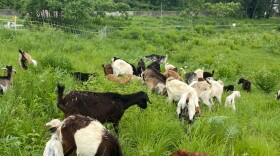-
Port KC has outsourced its lawn service needs to a herd of goats for the third year. They work for food while improving the environment, chewing away invasive brush and clearing the space for walkers and joggers.
-
The first English word for “lawn” dates back to the early 1500s, described as an “open space among trees.” Lawns today are a far cry from that description, but they’ve come to dominate our physical — and cultural — landscapes. Now concerns over environmental impacts are propelling yet another redefinition.
-
Indigenous grassland once dominated much of Kansas. A new program, backed by corporate beef buyers, is teaming up with ranchers to preserve what's left of the rare ecosystem. Plus: A Missouri representative is working on bipartisan legislation to expand the Child Tax Credit as well as business tax breaks.
-
In western Kansas, seas of corn and wheat stretch out across the plains, but a huge portion of those fields used to be native grassland. To conserve what’s left, a new program will work with ranchers, and it’s backed by some of the biggest beef buyers like Burger King.
-
Some of the very first homes in Kansas were built by members of the Wichita Tribe with cut bundles of native bluestem grass. A new generation of students at Haskell Indian Nations University are learning the skill, and reconnecting with a Great Plains tradition.
-
The groundskeeping legend, known in the discipline as "The Sodfather," worked for the Kansas City Chiefs for 26 years. This week, the 94-year-old is in Glendale, Arizona, where he's hard at work preparing State Farm Stadium for the Super Bowl game and Rihanna's halftime show.
-
Local homeowners have taken up the cause of No Mow May, which encourages people to temporarily pause their lawn-mowing in order to support the bees, butterflies and moths vital to pollination. In early spring, weeds are some of their prime food sources.
-
The man who helped make the Flint Hills country worth driving through is selling prime grassland that comes with perpetual conservation easements.
-
As COVID-19 restrictions ease, worries over going back to the workplace are rising and Kansas City real estate developer Bill Haw is selling his substantial acreage in the Flint Hills.
Play Live Radio
Next Up:
0:00
0:00
Available On Air Stations









